Gaiters is a word that appeared in the description clothing for sports training, or dancing. Knitted according to patterns, they helped warm up the leg muscles and made training more effective. Today, this item of clothing has migrated to the women's wardrobe, and has come to carry not only a practical, but also an aesthetic value of a fashionable item.
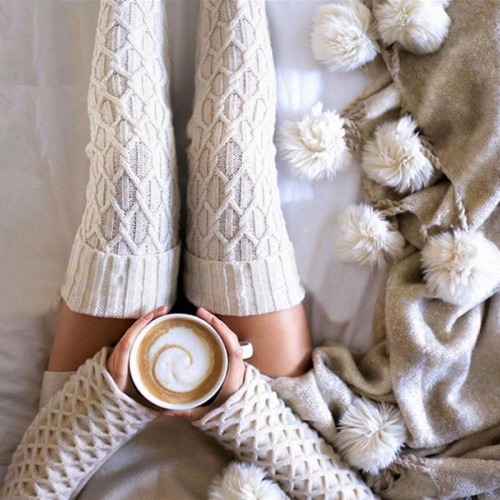
Knitted leg warmers are suitable for girls and women, especially for the cold season.. In the classic version, it is considered that leg warmers are stockings that do not have a toe part. For better fixation on the leg, as a rule, they begin and end with an elastic band.
Gaiters come in different heights:
- short (just above the ankles);
- medium length (to the knee);
- long (above the knee, like stockings or over-the-knee boots).

Purpose of women's gaiters:
- to emphasize the slenderness of women's legs,
- protect from the cold,
- disguise the imperfections of the shape of the legs.
Knitted leg warmers (patterns and descriptions are provided below) need to be able to be correctly incorporated into your image based on simple rules:
- Choose gaiters according to the season. If it is cold outside, then knitted gaiters made of wool or mohair are appropriate. In warm weather, it is worth turning to elastic, nylon or openwork gaiters made of cotton.
- Pay attention to your figure, its features. For fragile girls with thin legs, voluminous leg warmers with a braid pattern or colored horizontal stripes are acceptable. Stockings with a vertical or patent pattern will suit plump girls.
- The length of the leggings directly depends on the length of the clothes. The shorter the dress chosen, the longer the knitted accessory should be.
- When taking measurements for knitting leg warmers, you need to understand how they will be worn. If inside, then the measurements are taken directly on the foot, if for shoes, then you need to put them on first.
Knitting patterns for leg warmers for women with knitting needles
- Patent loop patterns;

- Braids:
- Pattern "braids on a mesh";
- Pattern "braids with extended loops".
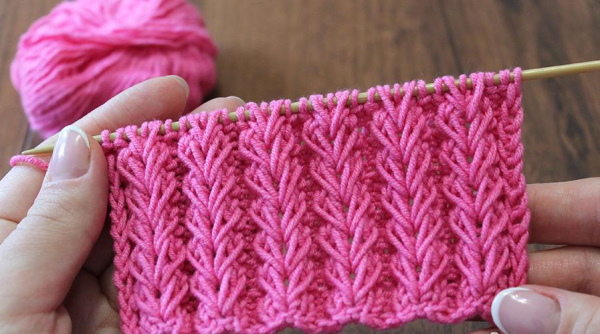
- Openwork knitting.
Simple Leg Warmers for Beginners
Knitted leg warmers, the patterns and descriptions of which are offered below, are suitable for people with a beginner level.
Materials:
- To knit simple thick leggings, you need yarn where 100 g is 200-250 m. You should not take pure wool threads (the fiber irritates the skin and shrinks a lot). A percentage ratio where wool is slightly more than half will do. You will need 300-400 g of yarn. More precise information can be found on the yarn label.
- The needles are selected depending on the knitting method - regular 2 pieces, or stocking 5 pieces, or circular needles. The size of the knitting needles is on the yarn label. Tailor's tape measure, sheet of paper, pencil.
Pattern, knitting scheme
English elastic.
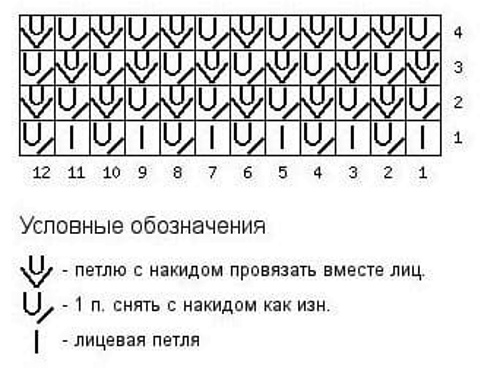
The patterns are suitable for knitting in the round.
Step-by-step knitting instructions:
- Take measurements: ankle circumference, calf circumference, leg circumference at the highest point of the product, gaiter height.
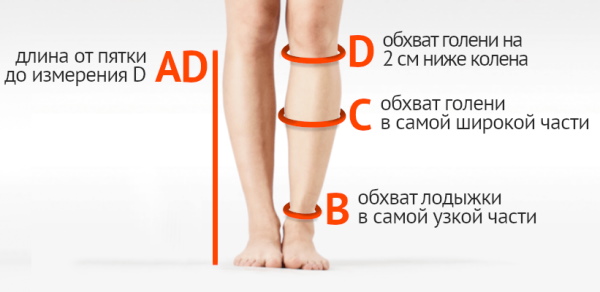
- Knit a small sample and calculate the stitches for casting on.
- Cast on the number of loops (even number) on 4 knitting needles equally and tie the work in a circle. Knit using the elementary elastic method. If you tighten the thread well, you will get a dense elastic. Knit 12 rows.
- Knit English rib without making any increases: 1st row: “pick up the yarn over and simply transfer the first loop from the left needle to the right (NOT behind the front wall), purl knit*, repeat until the end of the pattern; 2nd row: “knit and yarn over with one knit, make a yarn over and simultaneously transfer the purl loop from one needle to the other*, knit the entire row in this rhythm. According to the pattern, knit the height of the product minus the height of the elastic band at the bottom and minus the height of the securing elastic band at the top. Finish the stage with the 2nd row of the rapport.
- Make increases in pairs so that the pattern does not get lost and transfer the knitting to a regular elastic band, knitting front - front, together with the yarn over, back - back.

- The volume of the leg at the top is greater than at the ankle. At this stage, you need to calculate the increase loops - their number must be even. To avoid losing the rhythm of the pattern, the increases must be done in pairs. If you need to add 14 loops, then the total number of paired increases is 7. Calculate the loops between paired increases.
- Make an increase: knit the 1st loop as usual, make a cross yarn over with the working thread in the air behind the back wall, make the 2nd yarn over from the bridge of the previous row (lift the bridge with the working knitting needle, pick up the working thread). When knitting the next row - knit the 1st front loop, yarn overs - in order purl, front loop, continue according to the rib pattern 6-7 cm. Close the row.
Features and nuances:
- You can knit leg warmers on 5 knitting needles, or you can replace them with circular knitting needles and use the "Magic Wool" method (translated as a magic loop). It is convenient to knit narrow parts - leg warmers, socks, sleeves:
- To knit in a circle, cast on stitches according to the calculation plus 1. Leave a thread with a short end in front.
- The entire set of loops should be roughly divided in half. And in the gap, the line connecting the needles should be pulled out into a loop. Each needle has approximately half of the set of loops. The "beginning of the row" is on the lower needle.
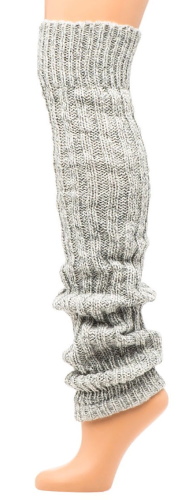
- Remove the final loop from the upper knitting needle and put it on the lower knitting needle. Transfer the second loop from the left to the right - pulling the loop from the upper knitting needle through it. Pull the short end of the thread - the knitting is carefully tightened. The additional loop goes away, closing the knitting in a circle. The loops with the threads remain below. The loops on the upper and lower knitting needles look in opposite directions, the beginning of knitting between parallel needles.
- Remove the lower knitting needle, the loops from it go to the fishing line. A free loop of the fishing line is formed to the left of the knitting. The working thread is behind the product. We hold the lower knitting needle with our right hand. At this time, it is the working one.
- Knit the row of the upper needle completely. The line from the knitting needles forms two opposite loops - one divides the loop row on the left, the second was obtained when knitting the working needle - on the right.
- We pull out the working needle, the loops from it are transferred to the fishing line.
- We pull the fishing line of the right loop so that the loops of the lower row are put on the knitting needle - it becomes working. The upper part is on the fishing line, the lower part is on the knitting needle.
- Turn the knitting 180 degrees.
- We repeat the process from point 5.
- To make the gaiters fit better on your leg, you can insert an elastic cord or spandex into the elastic band at the top and bottom.
- To knit the bottom elastic, you can use thinner knitting needles than those used to knit the main part. Then the work will be denser and better quality.
Leg warmers with knitting needles from melange yarn
Another option that does not require much knitting experience is mélange leggings. The color transitions embedded in the yarn create an interesting unique pattern and hide flaws in the quality of the work.
For gaiters 50 cm high and 18 cm in circumference the following will do:
- melange yarn "Burdjum batik" by Alize TM (acrylic, 100 g - 210 m) - 2-3 skeins;
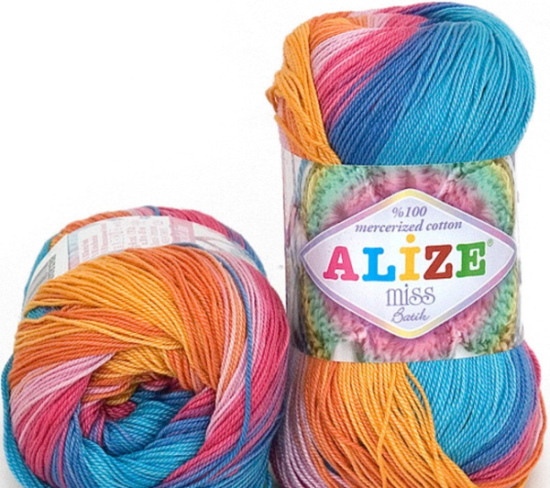
- knitting needles No.3.
Pattern, knitting diagram:
- Elastic band 2x2;
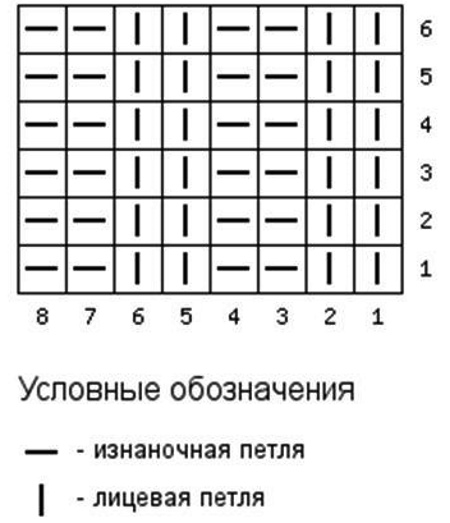
- Braid pattern.
Step by step knitting instructions
Below are three options for leg warmers made from melange yarn.
Option 1:
- Knit 40 loops. Knit a 2x2 ribbing tube 51 cm high. Close the loops.
Option 2:
- Cast on 40 stitches in a circle.
- Knit 4–5 cm of fabric using a 1x1 or 2x2 elastic band.
- Knit 40 cm of fabric using the stocking stitch technique.
- Bring the knitting to the end with a similar elastic band of about 5 cm. Close the row.
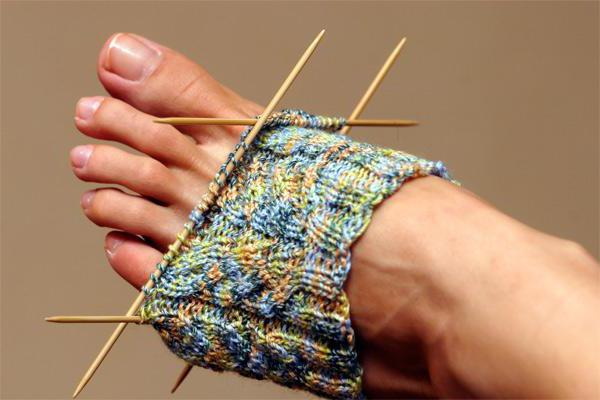 Knitted leg warmers, the patterns and description of which are offered by option 3, like braids, look voluminous and ornate, and working on them is quite simple. The yarn consumption for this option is about 100 grams more.
Knitted leg warmers, the patterns and description of which are offered by option 3, like braids, look voluminous and ornate, and working on them is quite simple. The yarn consumption for this option is about 100 grams more.
Option 3:
- Cast on 40 stitches.
- Knit the base of the leggings to a height of 4 cm using the selected elastic band.
- Make increases in pairs of loops using the method described in point 7 in the description of simple leg warmers for beginners. Knit paired increases through 10 loops 4 times. The result is a total of 48 loops.
- Knit the main height of the leg warmers with a "braid" pattern, repeating it from the 1st to the 20th row. Keep the rhythm of the 2 by 2 elastic throughout the knitting. Make sure that the pattern does not get lost. At the same time, you need to remove 12 loops before knitting. An additional needle will do for this. Knit the next 12 loops. Knit 12 loops from an additional knitting needle. Work another 24 loops. Repeat until the end of the row.
- Knit the next 9 rows according to the pattern.
- From the beginning of the 11th row, knit 24 loops with the same elastic. Remove 12 loops to another knitting needle behind the work. Knit the following loops and then only the previous 12 from an additional knitting needle. Repeat knitting to the end of the row.
- Knit 9 more rows.
- Finish the work with the elastic band used, approximately 3 cm.

Features and nuances:
- If you knit with melange yarn, without paying attention to the rhythm, the leggings will turn out with a different pattern.
- When you want the leg warmers pattern to be synchronous, take two separate skeins of yarn, find two identical color transitions at the beginning of each skein and start knitting each leg warmer from a certain section of your skein. You can use circular knitting needles with the Magic Wool method (included in the description of simple leg warmers for beginners) and knit both leg warmers at once. To do this, cast on 40 loops from the first skein onto circular knitting needles. Separately, cast on another 40 loops from the second skein onto the same knitting needles. Continue working according to the selected description.
- One of the fashion trends of youth fashion has become striped leggings. For them, you can take not melange yarn, but ordinary yarn of several colors that harmoniously match each other. For work, you can use only two colors or several colors. Take contrasting colors, or shades close to each other. Striped leggings will suit a sporty style, casual, boho, grunge.
Knee-high socks for girls
Leg warmers, connected with knee-highs, first appeared in the school uniform of students of elite colleges, and firmly established themselves in the description of preppy style clothing. Knee-highs go with jackets or soft jumpers, pleated skirts or loose-fitting dresses.
The knitting pattern for them is similar to knitting socks.
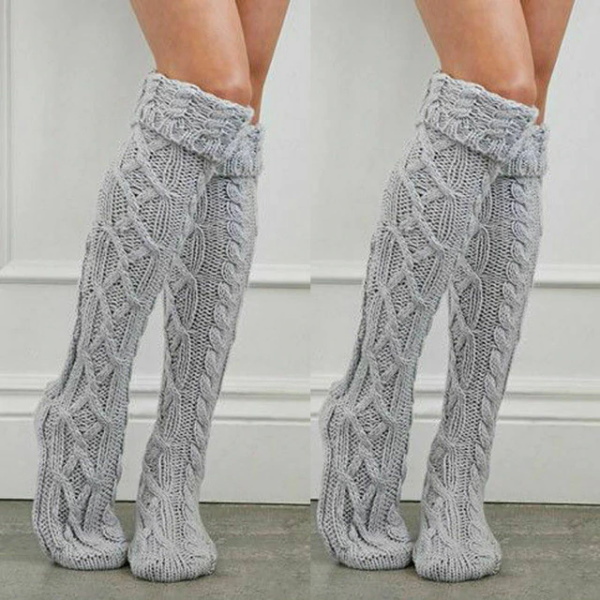
Materials and tools:
- Yarn Magic Dream, containing mohair and acrylic, 100 g - 268 m;
- knitting needles No.3;
- knitting needles No.2;
- hook No.2.
Pattern, knitting scheme
The density of stocking knitting with knitting needles No. 2 10 cm x 10 cm = 30 loops per 30 rows, openwork knitting with knitting needles No. 3 10 sq. cm corresponds to 10 loops per 15 rows.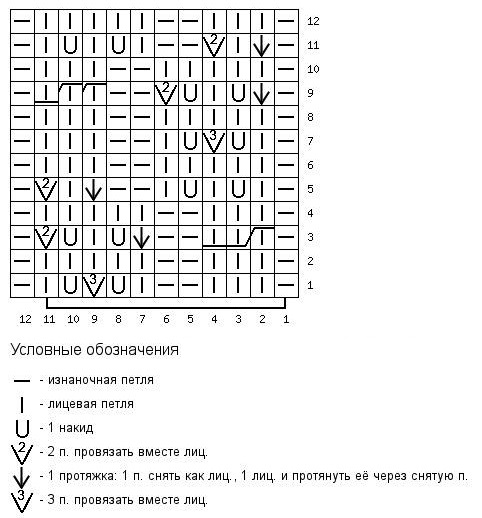
Step-by-step knitting instructions:
- Cast on 44 stitches using No.3 knitting needles.
- Knit 12 rows using a 2 x 2 elastic band.
- Make 65 rows using the openwork knitting pattern.
- Replace the No. 3 knitting needles with No. 2 double-pointed knitting needles.
- Knit 5 rows with the front surface, distributing the loops evenly on the needles.
- On knitting needles No. 1 and No. 4, tie the heel in a straight line according to the following pattern: initial row: 1 loop - front, 2 - simply remove as front (behind the front wall); 2nd row all purl.
- Knit 20 rows in total.
- Divide the knitting into three needles approximately equally (7+8+7).
- Bring knitting to the middle needle with 8 loops. Continue knitting the row of the middle needle straight and back, knitting together the last loop of the row from it with the first loop of the side needle. Knit like this until the side needles become free. And the 8 loops will become the base from the bottom of the heel.
- From the sides of the heel, cast on 10 loops on knitting needles No. 1 and No. 4. Divide the 8 loops of the heel in half on these knitting needles. Now on knitting needles No. 1 and No. 4 there are 14 loops each, on knitting needles No. 2 and No. 3 there are 11 loops each.
- Continue knitting in the round. In each row, decrease 1 stitch from needles No. 1 and No. 4, knitting them in pairs until there are 11 stitches left on them.
- Continue working in a circle for another 48 rows (or to the level of the little finger).
- Knit the toe of the sock: in each row, join 2 loops into one from the side seams on both the upper and lower needles (4 loops will be decreased in each row). Continue decreasing to the last 4 loops.
- Thread the remaining loops onto the end of the thread and tighten.
- Crochet a cord from air loops and pass it along the top of the golf, tie it.
Features and nuances:
- To decorate the top, you can wind pom-poms and secure them to the product with a cord.
Women's cotton leggings
Leg warmers, knitted with knitting needles (patterns and description of openwork are attached) made of cotton - most often a summer option. Cotton fabric does not irritate and is suitable for people with sensitive skin. Cotton leg warmers are worn with a dress with a floral print, or denim shorts, a skirtThere are many different types of shoes that you can wear with cotton leggings: pumps, sneakers, rough boots with flat soles.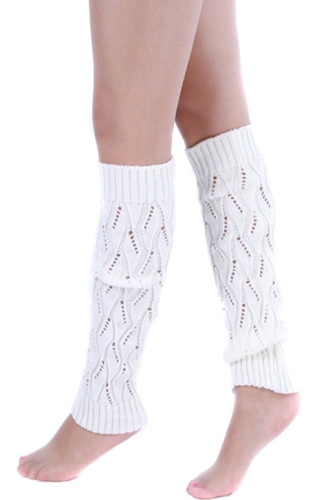
Materials and tools:
- Linen yarn Russia PT (Linen with cotton) 100g - 2-3 skeins, knitting density 28 sts = 10 cm.
- Knitting needles No. 3, No. 2.5 - select a knitting needle thickness slightly thicker than the thickness of the thread (about 1 mm).
Pattern, knitting scheme
Step-by-step knitting instructions:
- 80 loops of the initial order are counted on the needles, 20 loops each.
- Knit English rib 1x1 (included in the description “Simple leggings for beginners”) about 4 cm.
- Knit an openwork pattern according to the 15 cm pattern, reproduce the pattern 10 times.
- Without deviating from the openwork pattern, on the 1st and 4th knitting needles, make decreases in mirror image by 1 loop.
- Decrease in row multiple of 8 an additional 7 times. There should be 64 stitches remaining.
- Continue knitting the openwork until the height of the product is 38 cm.
- Finish with an English elastic band for another 4 cm.
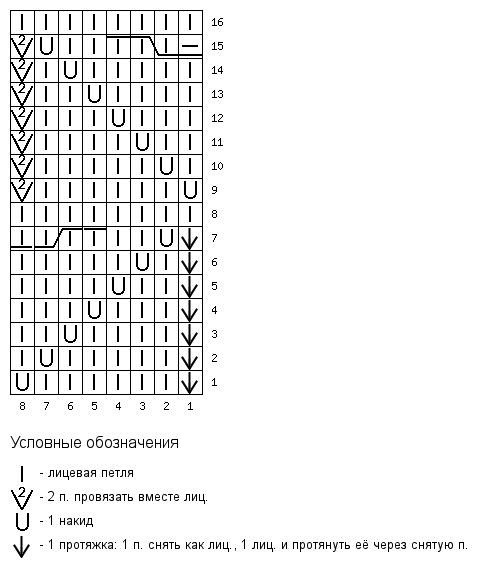
Features and nuances:
- To get good quality leggings from cotton, you will need a little more patience, because the cotton thread is not elastic, and you have to constantly monitor its tension while working.
- It is preferable to choose yarn colors that are not bright. Saturated cotton colors may fade when washed, and the product will not look neat. It is better to choose natural colors.
Knitted wool leg warmers
Wool leg warmers are relevant during cold weather. They go with high boots, rough leather shoes, and high-heeled shoes. In addition to leg warmers, you can knit socks from the same yarn, or wear them with mittens.
To knit leg warmers, you can simply use an elastic band along their entire length, a relief pattern (braids, openwork, cones) or a jacquard pattern. For example, you can knit leg warmers with a "snowflake" pattern.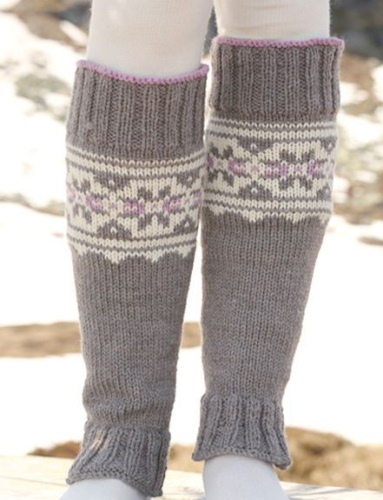
Materials and tools:
- Yarn "Warm and cozy" Russia PT 100% wool 100 gr 390 m sapphire - 2 skeins;
- Shimmering yarn Russia PT 96% acrylic 4% metanit 100 g h 430 m (for the pattern) - 1 skein;
- Knitting needles 5 pcs or circular No. 3;
Pattern, knitting scheme
Step-by-step knitting instructions:
- Using a double sapphire thread, form a cast-on row of 80 stitches.
- Knit 20 rows in a circle using a simple elastic band.
- Cut one thread and remove it from the work.
- Introduce a shimmering thread into the work.
- Go to knitting jacquard pattern. Description is given for one rapport, add it 3 more times.

| Row | 1 rapport |
| 1 | 2 loops sapphire, 1 shimmer, 3 sapphire, 1 shimmer, alternate 3 loops sapphire, 1 shimmer |
| 2 | execute in sapphire color |
| 3 | execute in sapphire color |
| 4 | 1 shimmering, 3 sapphire |
| 5 | 2 shimmer, 8 sapphire, 1 shimmer, 8 sapphire, 1 shimmer loop. When you need to knit a large section of one color, then to avoid stretching inside the product, you can twist both threads between each other 1-2 turns from time to time. |
| 6 | 1 shimmer, 2 sapphire, repeat 2 more times, 3 shimmer loops, 2 sapphire, 1 shimmer, 2 sapphire, 1 shimmer, 2 sapphire |
| 7 | 3 sapphire, 1 shimmering, 2 sapphire, 2 shimmering, 2 sapphire, 1 shimmering, 2 sapphire, 2 shimmering, 2 sapphire, 1 shimmering, 2 sapphire |
| 8 | 1 sapphire, 3 shimmering, 2 sapphire, 3 shimmering, 3 sapphire, 3 shimmering, 2 sapphire, 3 shimmering; |
| 9 | 4 sapphire, 1 shimmering, 1 sapphire, 4 shimmering, 1 sapphire, 4 shimmering, 1 sapphire, 1 shimmering and 3 sapphire; |
| 10 | 5 sapphire, 1 shimmering, 1 sapphire, 3 shimmering, 1 sapphire, 3 shimmering, 1 sapphire, 1 shimmering, 4 sapphire |
| 11 | 1 sapphire, 4 shimmering,1 sapphire, 1 shimmering, 1 sapphire, 2 shimmering, 1 sapphire, 2 shimmering, 1 sapphire, 1 shimmering, 1 sapphire, 4 shimmering |
| 12 | 2 Sapphire, 4 Shimmering, 1 Sapphire, 1 Shimmering, 1 Sapphire, 1 Shimmering, 1 Sapphire, 1 Shimmering, 1 Sapphire, 1 Shimmering, 1 Sapphire, 4 Shimmering, 1 Sapphire |
| 13 | 1 shimmer, 2 sapphire, 4 shimmer, 1 sapphire, 1 shimmer, 3 sapphire, 1 shimmer, 1 sapphire, 4 shimmer, 2 sapphire. |
| 14 | 2 shimmer, 2 sapphire, 4 shimmer, 2 sapphire, 1 shimmer, 2 sapphire, 4 shimmer, 2 sapphire, 1 shimmer |
| 15 | 1 sapphire, 2 shimmering, 6 sapphire, 3 shimmering, 6 sapphire, 2 shimmering |
| 16 | similar to row 14 |
| 17 | similar to row 13 |
| 18 | similar to row 12 |
| 19 | similar to row 11 |
| 20 | similar to row 10 |
| 21 | similar to row 9 |
| 22 | similar to row 8 |
| 23 | similar to row 7 |
| 24 | similar to row 6 |
| 25 | similar to row 5 |
| 26 | similar to row 4 |
| 27 | knit entirely with sapphire thread |
| 28 | knit entirely with sapphire thread |
| 29 | similar to row 1 |
- Remove the shimmering thread from the knitting.
- Knit 56 rows in sapphire color.
- Attach the second additional thread and knit the elastic band as at the beginning of the work. Finish the work.
If you want to knit leg warmers, before you start working, you should imagine what they should be like (color, shape), what additions will be suitable for realizing the intended image (pompoms, imitation of button fastening).
Next, you need to choose a pattern with a description and sit down to knit. As a result, your wardrobe will have not only a fashionable, but also a unique thing that will not only warm your feet, but also please the needlewoman with a pleasant appearance.
Video about knitting leg warmers
Leg warmers for girls:
